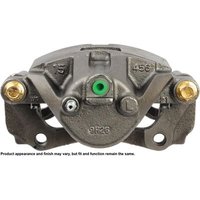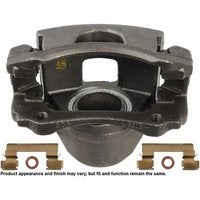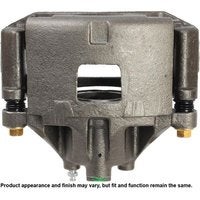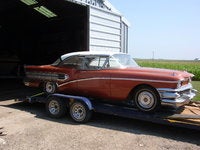Front brakes
5 Answers
enginecreator answered 7 years ago
They use the power from the brake fluid to push against cylinders that in turn press against the brake pads that in turn press against the brake rotors to stop the car.
enginecreator answered 7 years ago
wiki quotes/:; The brake caliper is the assembly which houses the brake pads and pistons. The pistons are usually made of plastic, aluminium or chrome-plated steel. Calipers are of two types, floating or fixed. A fixed caliper does not move relative to the disc and is thus less tolerant of disc imperfections. It uses one or more pairs of opposing pistons to clamp from each side of the disc, and is more complex and expensive than a floating caliper. A floating caliper (also called a "sliding caliper") moves with respect to the disc, along a line parallel to the axis of rotation of the disc; a piston on one side of the disc pushes the inner brake pad until it makes contact with the braking surface, then pulls the caliper body with the outer brake pad so pressure is applied to both sides of the disc. Floating caliper (single piston) designs are subject to sticking failure, caused by dirt or corrosion entering at least one mounting mechanism and stopping its normal movement. This can lead to the caliper's pads rubbing on the disc when the brake is not engaged or engaging it at an angle. Sticking can result from infrequent vehicle use, failure of a seal or rubber protection boot allowing debris entry, dry-out of the grease in the mounting mechanism and subsequent moisture incursion leading to corrosion, or some combination of these factors. Consequences may include reduced fuel efficiency, extreme heating of the disc or excessive wear on the affected pad. A sticking front caliper may also cause steering vibration. Another type of floating caliper is a swinging caliper. Instead of a pair of horizontal bolts that allow the caliper to move straight in and out respective to the car body, a swinging caliper utilizes a single, vertical pivot bolt located somewhere behind the axle centerline. When the driver presses the brakes, the brake piston pushes on the inside piston and rotates the whole caliper inward, when viewed from the top. Because the swinging caliper's piston angle changes relative to the disc, this design uses wedge-shaped pads that are narrower in the rear on the outside and narrower on the front on the inside. he most common caliper design uses a single hydraulically actuated piston within a cylinder, although high performance brakes use as many as twelve. Modern cars use different hydraulic circuits to actuate the brakes on each set of wheels as a safety measure. The hydraulic design also helps multiply braking force. The number of pistons in a caliper is often referred to as the number of 'pots', so if a vehicle has 'six pot' calipers it means that each caliper houses six pistons. Brake failure can result from failure of the piston to retract, which is usually a consequence of not operating the vehicle during prolonged storage outdoors in adverse conditions. On high-mileage vehicles, the piston seals may leak, which must be promptly corrected.



